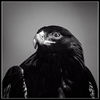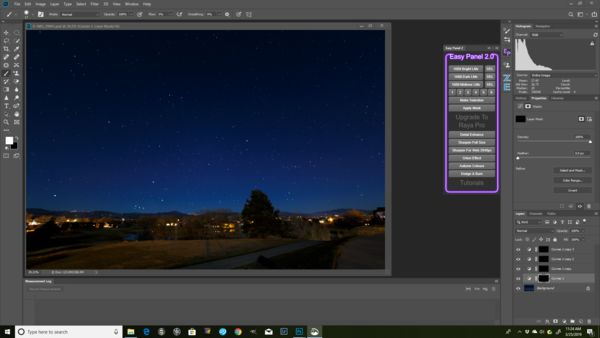Making stars stand out in the night sky -- Part 2: Using Luminosity Masks
Mar 25, 2019 16:40:30 #
This is part two of a two-part explanation of the procedure involved in getting stars, in a nighttime shot, to appear brighter, but without making everything else look brighter. This part deals with the Luminosity mask, itself – how to create it, modify it (might be the most important part), and use it.
The original thread that generated a request for this explanation is here: Star light, star bright -- Where the hell are the Northern Lights?
There are various tools available that will create luminosity masks, and there are youtube videos that show how to use them. Personally, I use Zone System Express, from Blake Rudis. This product is not free, so I won’t go through what I do with it. Instead, I’ll use another product, which is free, from Jimmy McIntyre. The product is Easy Panel 2. Find it, and a tutorial on its use, here: https://www.shutterevolve.com/easy-panel-2-0-free-16-bit-luminosity-mask-panel/
At this point, the photo should have been sharpened according to the procedure in Part 1. From now on, we will be in Photoshop. It is assumed the sharpened photo has been exported to Photoshop. Notice Easy Panel 2.0, on the right. (Figure 1)
Since we are interested in stars, let’s create the Bright Luminosty masks, by clicking on “16Bit Bright LMs”. You’ll notice some new layers being created. You’ll want to open the group named Masks. (Figure 2)
You will want to investigate what each mask looks like, in order to determine which one you will want to use. Do this by holding the Alt key (on a PC) while clicking a mask. That will show you the mask, in black and white. Use Alt while clicking the mask to get back to the original photo display. I have determined that Mask #1 is the one I want. (Figure 3)
That mask shows the stars, which is where my interest lies. But, this mask has too much other stuff, to be of use. I have to modify this mask.
Go back to the original display (Alt + click). Select the appropriate mask layer (in my case, Mask 1). Then, click on “Make Selection” on Easy Panel 2.0. You might, or might not, see marching ants, depending upon how much was selected.
After you have made that selection, create a Curves adjustment layer. The selection you made in the previous step will automatically be applied to the mask of your new Curves adjustment layer.
If we were to adjust the curve, right now, too much of the photo would be brightened. We have to adjust the mask, first. Press the Alt key while clicking on the mask of the Curves adjustment layer. You should see the black and white mask. While the mask is displayed, go to the “Image” menu item, at the top, select the “Adjustments” submenu, then select the “Levels” item. Your screen should look like this: (Figure 5)
In the little Levels window, we will adjust the three sliders immediately below the graph. (This could get quite long, unless I assume that you have some knowledge of what these sliders do.) The idea, here, is to make the parts you want to be very bright (by sliding the right slider to the left), and the dark parts very dark (by sliding the left slider to the right). Most of the time you do this, you’ll have a lot of room between the left and right sliders, when you are finished, and you can use the middle slider to fine tune it. In our case, there won’t be any room. (Figure 6)
Notice the grouping of the sliders. If you were to look at the download, you’d see the stars being pretty bright. Click “OK”.
We now have a mask that will let us work on the stars, but there is still some stuff on the bottom that we do not want to be affected, when we adjust things. Use the brush tool, to paint black in those areas, on the mask. (Figure 7)
Notice that we’ve eliminated the lights on land, from this mask. If you look at the download, this will be more apparent.
Hold the Alt key while clicking on the mask icon. This will bring you back to the display of the photo, itself, instead of the mask. (Figure 8)
At this point, you can adjust the curve, as shown in Figure 8, and only the stars will brighten.
At this point, you can only brighten those stars, so much. What if you want them to be brighter? Simply copy that Curves adjustment layer, by hitting CTL-J (on a PC). Do this as many times as you feel necessary. In our case, I duplicated that layer three times, for a total of four layers. (Figure 9)
See how much brighter the stars are, compared with the original. But, there is more we can do.
Take a close look at the line of the mountains. On the left side, you see an area of snow-capped mountains. You can also see an area of snow-capped mountains just to the right of center. I want those be brighter, so the viewer can see them. I could have left those snow-capped mountains in the masks, but they would have been brightened four times. Trust me, that’s too bright. So, we’ll modify, slightly, the mask of the first Curves adjustment layer
Select the first Curves adjustment layer. Use the brush tool, and paint white over the snow-capped mountain areas. For this, I used a small brush with a very soft edge. Here may be the most important part of this step. Set the “Flow” parameter very low, for this step. I set it to 5. If the value of this parameter is less than 100, each time you use the brush over the same area, you will put down more of what the brush has (in this case, white). I did not want the mountains to be super bright, so I used a very low flow, with just a few brushes. And, I only did it to this one layer. (Figure 10)
Here is the finished product. Compare it with the original. The stars (and the snow-capped mountains) are the only spots brighter than they were in the original. The download really shows this. (Figure 11)
I hope this was easy enough to follow.
The original thread that generated a request for this explanation is here: Star light, star bright -- Where the hell are the Northern Lights?
There are various tools available that will create luminosity masks, and there are youtube videos that show how to use them. Personally, I use Zone System Express, from Blake Rudis. This product is not free, so I won’t go through what I do with it. Instead, I’ll use another product, which is free, from Jimmy McIntyre. The product is Easy Panel 2. Find it, and a tutorial on its use, here: https://www.shutterevolve.com/easy-panel-2-0-free-16-bit-luminosity-mask-panel/
At this point, the photo should have been sharpened according to the procedure in Part 1. From now on, we will be in Photoshop. It is assumed the sharpened photo has been exported to Photoshop. Notice Easy Panel 2.0, on the right. (Figure 1)
Since we are interested in stars, let’s create the Bright Luminosty masks, by clicking on “16Bit Bright LMs”. You’ll notice some new layers being created. You’ll want to open the group named Masks. (Figure 2)
You will want to investigate what each mask looks like, in order to determine which one you will want to use. Do this by holding the Alt key (on a PC) while clicking a mask. That will show you the mask, in black and white. Use Alt while clicking the mask to get back to the original photo display. I have determined that Mask #1 is the one I want. (Figure 3)
That mask shows the stars, which is where my interest lies. But, this mask has too much other stuff, to be of use. I have to modify this mask.
Go back to the original display (Alt + click). Select the appropriate mask layer (in my case, Mask 1). Then, click on “Make Selection” on Easy Panel 2.0. You might, or might not, see marching ants, depending upon how much was selected.
After you have made that selection, create a Curves adjustment layer. The selection you made in the previous step will automatically be applied to the mask of your new Curves adjustment layer.
If we were to adjust the curve, right now, too much of the photo would be brightened. We have to adjust the mask, first. Press the Alt key while clicking on the mask of the Curves adjustment layer. You should see the black and white mask. While the mask is displayed, go to the “Image” menu item, at the top, select the “Adjustments” submenu, then select the “Levels” item. Your screen should look like this: (Figure 5)
In the little Levels window, we will adjust the three sliders immediately below the graph. (This could get quite long, unless I assume that you have some knowledge of what these sliders do.) The idea, here, is to make the parts you want to be very bright (by sliding the right slider to the left), and the dark parts very dark (by sliding the left slider to the right). Most of the time you do this, you’ll have a lot of room between the left and right sliders, when you are finished, and you can use the middle slider to fine tune it. In our case, there won’t be any room. (Figure 6)
Notice the grouping of the sliders. If you were to look at the download, you’d see the stars being pretty bright. Click “OK”.
We now have a mask that will let us work on the stars, but there is still some stuff on the bottom that we do not want to be affected, when we adjust things. Use the brush tool, to paint black in those areas, on the mask. (Figure 7)
Notice that we’ve eliminated the lights on land, from this mask. If you look at the download, this will be more apparent.
Hold the Alt key while clicking on the mask icon. This will bring you back to the display of the photo, itself, instead of the mask. (Figure 8)
At this point, you can adjust the curve, as shown in Figure 8, and only the stars will brighten.
At this point, you can only brighten those stars, so much. What if you want them to be brighter? Simply copy that Curves adjustment layer, by hitting CTL-J (on a PC). Do this as many times as you feel necessary. In our case, I duplicated that layer three times, for a total of four layers. (Figure 9)
See how much brighter the stars are, compared with the original. But, there is more we can do.
Take a close look at the line of the mountains. On the left side, you see an area of snow-capped mountains. You can also see an area of snow-capped mountains just to the right of center. I want those be brighter, so the viewer can see them. I could have left those snow-capped mountains in the masks, but they would have been brightened four times. Trust me, that’s too bright. So, we’ll modify, slightly, the mask of the first Curves adjustment layer
Select the first Curves adjustment layer. Use the brush tool, and paint white over the snow-capped mountain areas. For this, I used a small brush with a very soft edge. Here may be the most important part of this step. Set the “Flow” parameter very low, for this step. I set it to 5. If the value of this parameter is less than 100, each time you use the brush over the same area, you will put down more of what the brush has (in this case, white). I did not want the mountains to be super bright, so I used a very low flow, with just a few brushes. And, I only did it to this one layer. (Figure 10)
Here is the finished product. Compare it with the original. The stars (and the snow-capped mountains) are the only spots brighter than they were in the original. The download really shows this. (Figure 11)
I hope this was easy enough to follow.
Figure 1
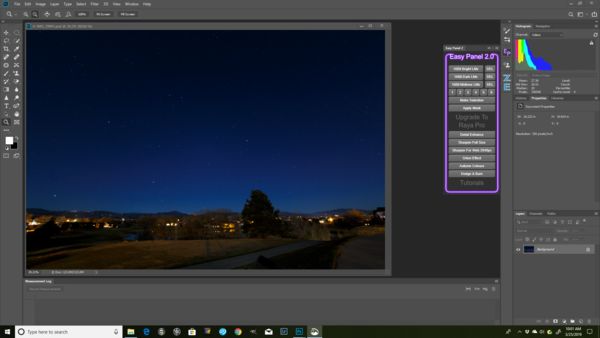
(Download)
Figure 2
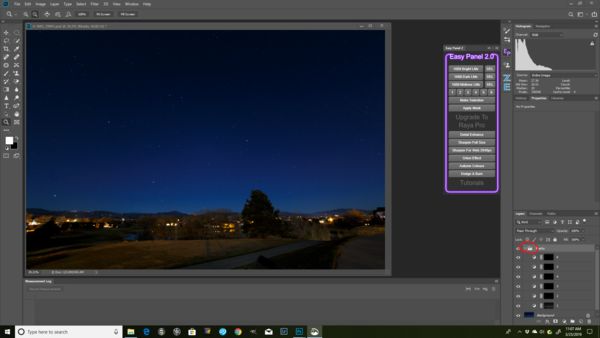
(Download)
Figure 3
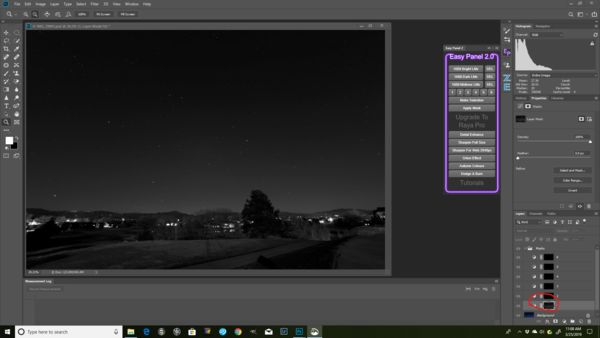
(Download)
Figure 4
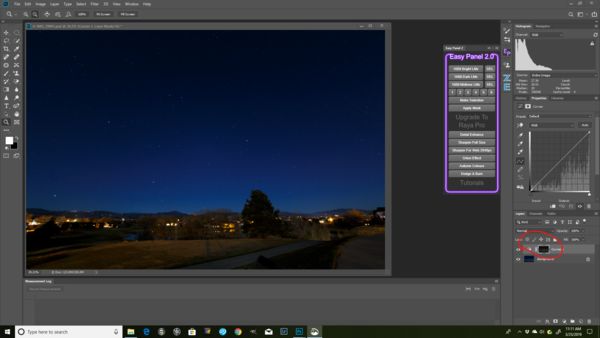
(Download)
Figure 5
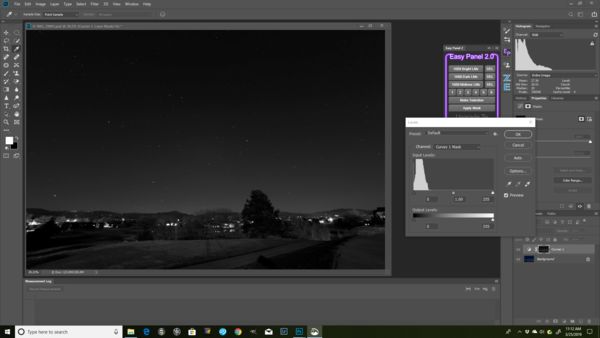
(Download)
Figure 6
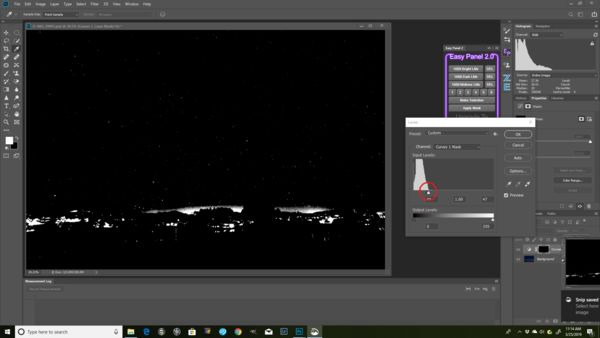
(Download)
Figure 7
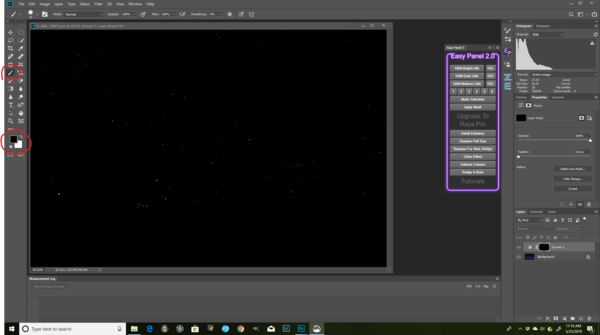
(Download)
Figure 8
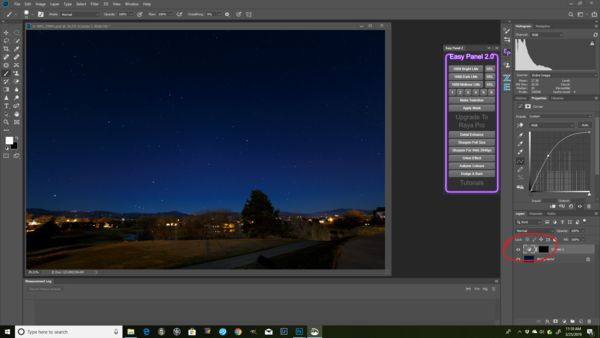
(Download)
Figure 9
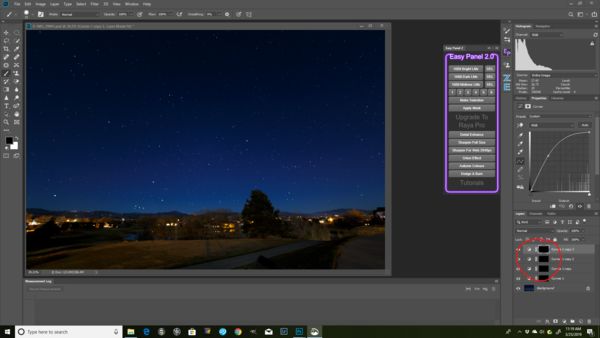
(Download)
Figure 10
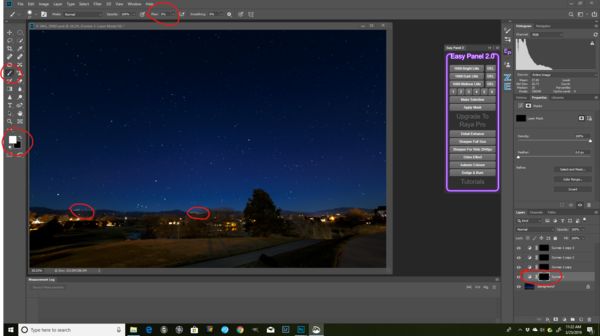
(Download)
Mar 25, 2019 16:43:24 #
Mar 25, 2019 17:31:17 #
So grateful for your time in doing these, Jim. You represent the best of UHH!
Mar 25, 2019 19:04:27 #
If you want to reply, then register here. Registration is free and your account is created instantly, so you can post right away.
